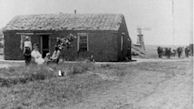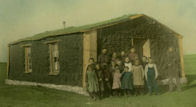
In 1862, the United States Congress passed the Homestead Act, which turned over large amounts of public land to private citizens. Homesteaders were able to claim 160 acres of land and were required to make improvements to the land, which included building a house on it within six months. On the Great Plains, where trees were scarce, many homesteaders built homes out of sod, which was jokingly called “Nebraska marble.” For more information on sod houses, explore these resources from the Smithsonian Institution or NebraskaStudies.org.
The house on the homestead of Herman Staberg is one example of a residence made of sod. Sod was not only used for houses, but for other buildings as well. This school in Cheyenne County and this church in Funk were both made out of sod. 
More images of sod buildings can be seen in Nebraska Memories.
Visit Nebraska Memories to search for or browse through many more historical images digitized from photographs, negatives, postcards, maps, lantern slides, books and other materials.
Nebraska Memories is a cooperative project to digitize Nebraska-related historical and cultural heritage materials and make them available to researchers of all ages via the Internet. Nebraska Memories is brought to you by the Nebraska Library Commission. If your institution is interested in participating in Nebraska Memories, see http://www.nlc.state.ne.us/nebraskamemories/ for more information, or contact Beth Goble, Government Information Services Director, or Devra Dragos, Technology & Access Services Director.
Search the Blog
Categories
- Books & Reading
- Broadband Buzz
- Census
- Education & Training
- General
- Grants
- Information Resources
- Library Management
- Nebraska Center for the Book
- Nebraska Memories
- Now hiring @ your library
- Preservation
- Pretty Sweet Tech
- Programming
- Public Library Boards of Trustees
- Public Relations
- Talking Book & Braille Service (TBBS)
- Technology
- Uncategorized
- What's Up Doc / Govdocs
- Youth Services
Archives
Subscribe


Imagine if they had to stay inside. We don’t have it so bad.